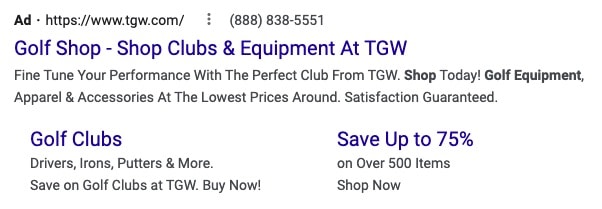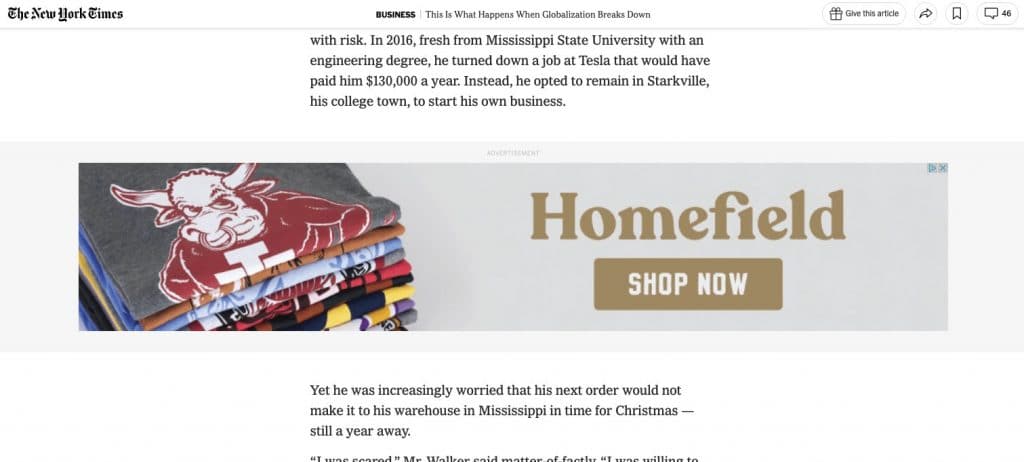Google Ads (previously Google Adwords) makes setting up ad groups and ads for your business services or products simple. But even with all of its endearing, useful automation features –setting up Google Ads can get confusing, fast. What’s the difference between Search Ads and Display Ads? What about Display Ads and Youtube Ads? What type of ads are the right ads for YOUR business?
7 most common types of Google Ads For Campaigns
On the surface, it may seem like these ads are all attempting to accomplish the same thing; when we take a closer look, we can see that each ad serves a different purpose, and each ad group created in your Google Ads account will have its own unique set of goals.
These different types of Google ads are:
Keep reading for a quick rundown of the main types of ads, and their differences.
RSAs — Responsive Search Ads
Responsive Search Ads are the most common type of Google Ads. These ads appear when specific search terms are queried using Google. For example, if a potential customer types “sweaters” into the Google search bar and your company sells different types of women’s sweaters, this may trigger Google into showing your ad based on the keywords in your ad group. Additionally, if more specific keywords are searched, such as “purple women’s sweater”, your ad may have a higher chance of showing up during the user’s search.

When creating an RSA, you add multiple headlines and descriptions, and Google’s algorithm will choose which headline and description combination to run for each query. It’s important to note that the higher your budget is when the ad launches, the higher chance the ad has of showing, and the higher the chance is that you will see an ROI on your advertisement. The longer an ad or ad group runs, Google will gather data on the relevance of your ads and ad copy, as well as how often users click-through to your site. When it comes to RSAs, relevancy is key to long-term success.
DSAs — Dynamic Search Ads
A Dynamic Search Ad, or DSA, is a type of search ad that relies heavily on Google’s algorithm and machine learning. If you have a well-organized site with multiple landing pages or a large, well-indexed inventory, DSA ads might be right for you.

With this type of ad, Google matches the potential customer’s search query to the landing page that it believes to be the most relevant based on site text. So, if your company sells different types of sports event tickets, potential customers may search for basketball tickets and see a dynamic ad for this weekend’s game.
Instead of providing Google with several headlines and descriptions for the search engine to cycle through, DSA’s require just two descriptions; Google will populate the advertisements and target users based on who is searching for your product or service.
These types of ads are quick to set up and may pick up keywords that users are actively searching for that you might have missed when setting up your RSAs. However, it’s important to note that because so much of the process with DSA is automated, you might not have very much control over what the ad will say and who it will show to. Because of this, and although DSAs can stand alone, it is smart to use RSAs in tandem with these ads to ensure that you’re capturing the most relevant users possible.
Call ads
Call ads, or ads that display your company’s phone number, appear for users searching your keywords on their mobile devices. These types of ads are easy and straightforward, and are mostly utilized to generate leads, as a phone call is a simple way to gather information about a potential customer or client. If your services are estimate-based, this may be right for you.

Display ads
Companies looking to increase their brand visibility often overlook how important and affordable running brand awareness advertisements can be. While they don’t often have the short-sales cycle of search ads, display ads play the long game. Display Ads, often employed in tandem with Search ads, will show users images or videos of your products or services. These ads almost always receive a high number of impressions, as they are less expensive to run than search ads.

According to Google, these types of ads show on over two million websites, to several thousand users a day. Because of this, Display ads are typically created to increase brand awareness for your company. It is important to note that while Display ads can include video ads, they are not the same as YouTube ads, discussed below.
Video ads
Video ads, or YouTube ads, are ads that are shown before or during a user watching a YouTube video. The most common form of these ads are pre-roll ads, or ads that play before the user watches their respective YouTube video.

Overlay ads
Another form of this ad are overlay ads — ads that sit at the bottom of the YouTube video. Generally, video ads lead to many impressions, which is why these types of ads are usually utilized for brand awareness ads, akin to Display ads.
This type of ad might also be right for you if your company offers something that is easier to understand when demonstrated, or if you need more than a few sentences of text to explain what your company provides or sells.
App ads
App ads, as the name suggests, are ads that promote your mobile device app. These ads are employed to encourage downloads of your app, and are shown to users on mobile devices, including phones and tablets.
Shopping ads
If you have an online store and are looking to grow your web shop sales, these ads may be right for you. Shopping ads are reserved for ecommerce companies selling many products, rather than a company offering one or two services. Shopping ads show the user specific product photos and prices, as well as a link to buy specific products they are searching for. These ads promote product sales and generate revenue; more specifically, these ads are normally used by companies that already have an established brand and are ready to increase their profitability.

Choosing the best type of Google ads for your business
The ad formats in Google Ads that you run depend on the needs and goals of your business. It also depends on your audience. Do they use YouTube frequently? Or do they primarily find information on specific services through a Google search? Knowing and understanding your audience and your industry’s niche will help influence the details of your ads and if it would benefit your business to supplement your Google ads with SEO or other marketing techniques.



